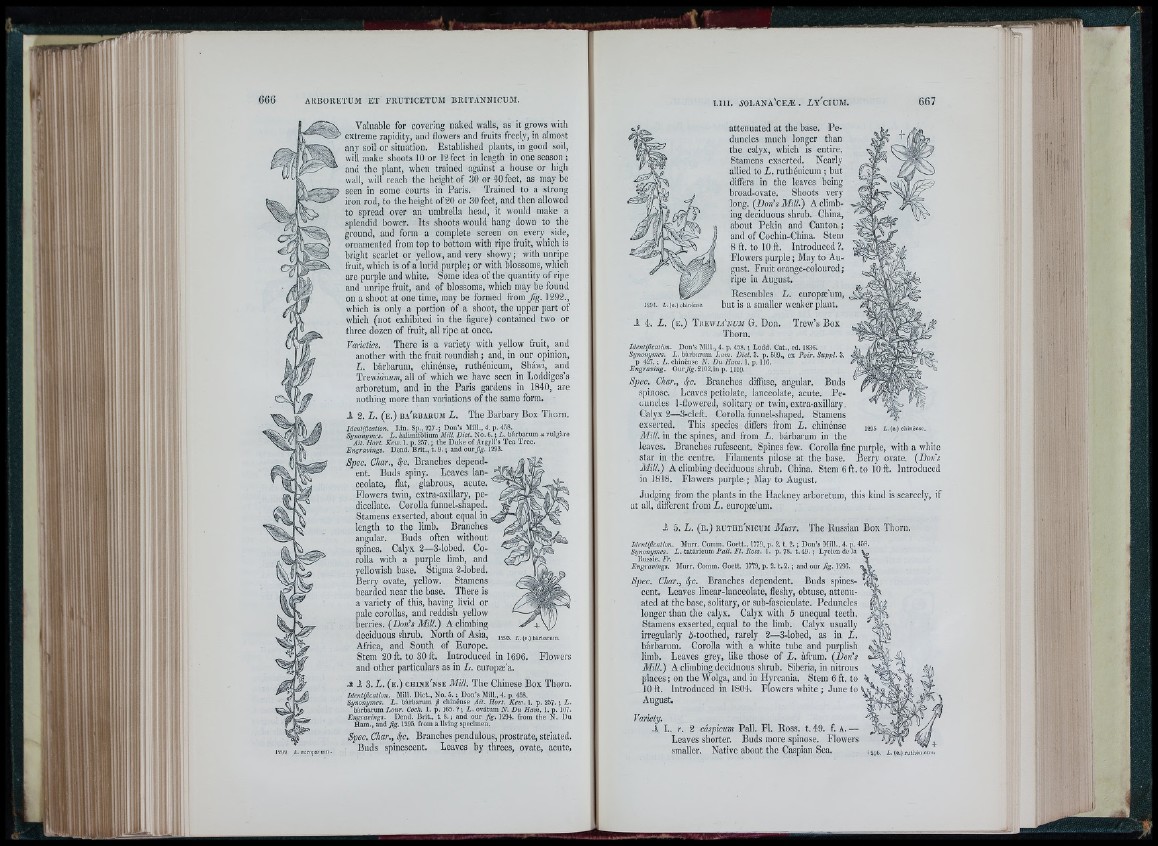
li ¿i
1292. Z..curoi>æ u
Valuable for covering naked walls, as it grows wich
extreme rapidity, and flowers and fruits freely, in almost
anv soil or situation. Established plants, in good soil,
will make shoots 10 or 12 feet in length in one season ;
and thc plant, when trained against a liouse or high
wail, will reach the heightof 30 or 40 feet, as maybe
seen in some courts in Paris. Trained to a strong
iron rod, to the height of 20 or 30 feet, and then allowed
to spread over an umbrella head, it would make a
splendid bower. Its shoots would hang down to the
ground, and form a complete screen on every side,
ornamented from top to bottom with ripe fruit, which is
bright scarlet or yellow, and very showy; with unripe
fruit, which is of a lurid purple; or with blossoms, which
are purple and white. Some idea of the quantity of ripe
and unripe fruit, and of blossoms, which may be found
on a shoot at one time, may be formed from fig. 1292.,
which is only a portion of a shoot, the upper part of
which (not exhibited in the figure) contained two or
three dozen of fruit, all ripe at once.
Varieties. There is a variety with yellow fruit, and
another with the fruit roundish ; and, in our opinion,
L. bárbarum, chinénse, ruthénicum, Sháwf, and
Trewfrtzmm, all of which we have seen in Loddiges’s
arboretum, and in the Paris gardens in 1840, are
nothing more than variations of the same form.
1 2. L. ( e . ) b a 'r u a r u m L. The Barbary Box Thorn.
Identification. Lin. Sp., 277. ; Don’s Mill., 4. p. 458.
Sunonvmes. L . Aalimifbiium Mill. Dict. No. 6. ; L. bfivbarura « vulgäre
Ait. Hort. Keiu. 1. p. 257.; the Duke of Argyll’s Tea Tree.
Engravings. Dend. Brit., t. 9. ; and o u r/g . 1293.
Spec. Char,, 4-c. Branches dependent.
Buds spiny. Lcaves lanceolate,
flat, glabrous, acute.
Flowers twin, extra-axillary, pedicellate.
Corolla funnel-shaped.
Stamens exserted, about equal in
length to the limb. Branches
angular. Buds often without
spines. Calyx 2—3-lobed. Corolla
with a purple limb, and
yellowish base. Stigma 2-lobed.
Berry ovate, yellow. Stamens
bearded near the base. There is
a variety of this, having livid or
pale corollas, and reddish yellow
berries. {Doris Mill.) A climbing
deciduous shrub. North of Asia,
1293. ft. (e.) bárbarum.
Africa, and South of Europe.
Stem 20 ft. to 30 ft. Introduced in 1696.
Flowers
and other particulars as in L. europæ'a.
Ai I Z .L . ( e . ) c h i n e 'n s e Mill. The Chinese Box Thorn.
Identification. Mill. Diet., No. 5. : Don’s Mill., 4. p. 458.
Synonymes. L . bárbarum ß chínense Ait. Hort. K ew .\. p. 257. ; L-
bárbarum Lour. Coch. 1. p. 165. ? ; L . ovàtum N. Du Ham. 1. p. 107.
Engravings. Dend. Brit., t. 8 .; and our fig. 1294. from the N. Du
Ham., and fi-g. 1295. from a living specimen.
Spec. Char., 4-c. Branches pendulous, prostrate, striated.
Buds spinescent. Leaves by threes, ovate, acute,
1291. ft. (e.) cbinénác.
attenuated at the base. Pe duncles
much longer than
the calyx, which is entire.
Stamens exserted. Nearly
allied to L. rutlienicuin ; but
differs in the leaves being
hroad-ovate. Shoots very
long. {Doris M ill.) A climbing
deciduous shrub. China,
about Pekin and Canton ;
and of Cochin-China. Stem
8 ft. to 10 ft. Introduced ?.
Flowers purple ; May to August.
Fruit orange-coloured;
ripe in August.
Resembles L. europæ'um,
but is a smaller weaker plant.
6 6 7
1295 ft.(e.)c5-.minsc.
1 4. L. ( e . ) TaEW/rti'NC/iif G. Don. Trew’s Box
Thorn.
Identification. Don's Mill., 4. p. 458. ; Lodd. Cat., ed. 1836.
Synonymes. I., bárbarum Lam. Dict. 3. p. 509., ex Poir. Suppl. 3.
p 427. ; L. chinénse N. Du Ham. 1. p. 116.
Engraving. O u r /g . 2102. in p. m o .
Spec. Char., 4'c. Bi'anches diffuse, angular. Buds
spinose. Lcaves petiolate, lanceolate, acute. Pe-
i,inicies 1-iiowered, solitary or twin, extra-axillary.
Calyx 2—3-cleft. Corolla funnel-shaped. Stamens
exserted. This species differs from L. chinénse
Mill, ill the spines, and from L. bárbarum in the
leaves. Branches rufescent. Spines few. Corolla fine purple, with a wliite
star in the centre. Filaments pilose at the base. Berry ovate. {Doris
Mill.) A climbing deciduous shrub. China. Stem 6 ft. to 10 ft. Introduced
in 1818. Flowers purple ; May to August.
Judging from the plants in the Hackney arboretum, this kind is scarcely, if
at all, different from L. europæ'um.
X 5. L. (e .) ru tiie'n icum Murr. The Russian Box Thorn.
Identification. Murr. Comm. Goett., 1779, p. 2. t. 2. ; Don’s Mill., 4. p. 458.
Synonymes. L . tatàricum Pall. Fl. Ross. 1. p. 78. t. 49. ; Lycien de la
Russie, Fr.
Engravmgs. Murr. Comm. Goett. 1779, p. 2. t.2 . ; and our fig. 1296.
Spec. Char., 4'C. Branches dependent. Buds spinescent.
Leaves linear-lanceolate, fleshy, obtuse, attenuated
at the base, solitary, or sub-fasciculate. Peduncles
longer than the calyx. Calyx with 5 unequal teeth.
Stamens exserted, equal to the limb. Calyx usually
irregularly 5-toothed, rarely 2—3-lobed, as in Z.
bárbarum. Corolla with a white tube and purplish
limb. Leaves grey, like those of L. afrum. (Doris
Mill.) A climbing deciduous shrub. Siberia, in nitrous
places ; on the Wolga, and in Ilyrcania. Stem 6 ft. to
10 ft. introduced in 1804. Flowerswhite; June to
August,
Vai'iety.
-A L. r. 2 cáspicum Pall. Fl, Ross. t,49. f. a .—
Leaves shorter. Buds more spinose. Flowers
smaller. Native about thc Caspian Sea. ¡.¿yo. i,. (e.)ruiiiéu.
I
\ I ?
i I
f '11 ij